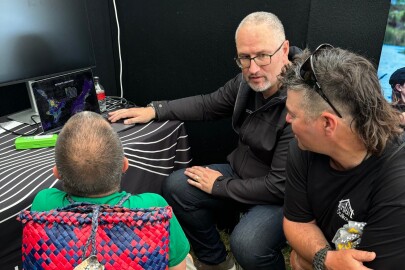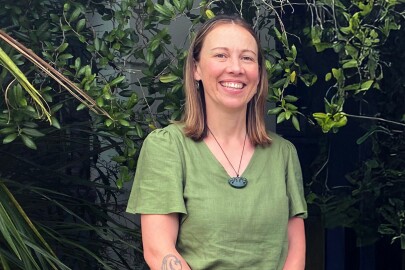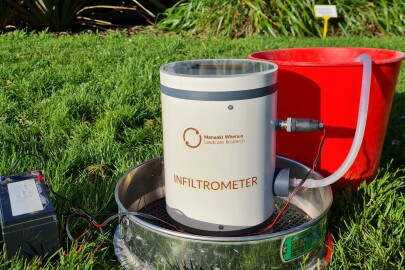Hui-ā-iwi

Holden Hohaia, Chief Advisor Te Tiriti Strategy, showcasing Manaaki Whenua's QGIS capabilities to whānau
In November, kaimahi from our Manaaki Taiao team traveled to Kaikōura to attend Hui-ā-iwi, showcasing our research to 2,000 Ngāi Tahu whānau.
The biannual event, this year hosted by by Te Rūnanga o Kaikōura, is a chance for Ngāi Tahu whānau, hapū and iwi to congregate and hear updates from Te Rūnanga o Ngāi Tahu, celebrate with Kapa Haka, kai, and kōrero, and learn about different businesses at market stalls.
This year, our Chief Advisor Te Tiriti Strategy Holden Hohaia, Senior Kairangahau Laise Harris, Senior Technician Paula Godfrey and Māori Communications Advisor Pip Swift travelled to Kaikōura. The team’s tech- savvy stall included showcasing our QGIS capabilities to whānau, as well as a Virtual Reality experience and a fun predator stamp activity for tamariki.
We also had flyers for whānau, highlighting our ability to partner with mana whenua on pest control projects, and helping them to understand more about the plants on their whenua.
Many constructive conversations were had with whānau, and we look forward to following up with these potential new partners.
Never treat soils like dirt
In contracted work for the Parliamentary Commissioner for the Environment (PCE) we recently provided an assessment of the impact of primary sector activities on Aotearoa New Zealand (AoNZ)’s soil, and implications for the ongoing productive capacity and sustainability of this resource. This is part of the PCE’s wider investigation into the environmental pressures associated with the extraction, processing, use, and disposal of natural resources.
We also contributed to a workshop at the Wasteminz conference with on sustainable management of surplus soils with contaminated land practitioners, central and local government as to the best ways to manage soils that are disturbed through land development processes.
Dr Ani Kainamu joins Kaihautū team

Dr Ani Kainamu
Our team of dedicated Kaihautū Māori Research Impact Leaders has grown stronger recently with the addition of Dr Ani Kainamu.
Ani, who is Ngāpuhi, Ngāti Kahu ki Whangaroa, joined us last year from Te Kūwaha, the National Centre of Māori Environmental Research, at NIWA.
Her areas of interests are Indigenous food systems and environmental management approaches, using holistic and multi-disciplinary approaches.
Ani completed her PhD titled “Ma uka ma kai, Ki uta ki tai: The ecological, social and cultural values of estuarine shellfisheries in Hawai`i and Aotearoa” within the School of Biology and Ngāi Tahu Research Centre, at Canterbury University and Hawai’i Pacific University in 2017.
Ani has joined Dr Nikki Harcourt and Dr Shaun Awatere, forming a strong trio of Kaihautū, who along with our GM Māori Partnerships Dr Nancy Garrity support and facilitate our strong partnerships with mana whenua.
Farmer-friendly infiltrometer now available

Farmer-friendly infiltrometer now available
Weather events over recent years have motivated farming, industry, and environmental protection authorities to search for ways to minimise environmental pollution. One way of achieving this goal is to increase agricultural water-use efficiency and manage storm water generation more efficiently on-farm. To do this, it is essential to understand soil water infiltration rates in farm catchments. The ideal device is simple, portable, and ready for use by research personnel, consultants, and farmers anywhere, with or without mobile phone coverage.
As part of an MBIE research programme to develop smarter tools to maximise the value of irrigation, soil scientists Veronica Penny and Dr Jagath Ekanayake at Manaaki Whenua have designed a cost-effective, farmer- friendly infiltrometer to meet these user requirements. It fits easily in a backpack, uses a built-in touch screen to activate, and displays infiltration rates without having to edit or enter details. It’s also smartphone-compatible via Bluetooth, allowing time-series data to be downloaded to the phone or emailed to the user once in cellphone range.
More information
Developing Smarter Tools for Maximizing the Value of Irrigation: Infiltrometers
Contact
Jagath Ekanayake
ekanayakej@landcareresearch.co.nz
